Phase Stability and Mechanical Properties of Al8Fe4RE via First-Principle Calculations
Abstract
1. Introduction
2. Computational Details
3. Results and Discussion
3.1. Phase Stability
3.2. Mechanical Properties
3.3. Electronic Properties
3.4. Lattice Dynamical Properties
4. Summary
Supplementary Materials
Author Contributions
Funding
Conflicts of Interest
References
- Sasaki, T.T.; Ohkubo, T.; Hono, K. Microstructure and mechanical properties of bulk nanocrystalline Al–Fe alloy processed by mechanical alloying and spark plasma sintering. Acta Mater. 2019, 57, 3529–3538. [Google Scholar] [CrossRef]
- D’Angelo, L.; D’Onofrio, L.; Gonzalez, G. Nanophase intermetallic FeAl obtained by sintering after mechanical alloying. J. Alloy. Compd. 2009, 483, 154–158. [Google Scholar] [CrossRef]
- Wu, H.; Baker, I.; Liu, Y.; Wu, X.; Cheng, J. Magnetically-triggered heating of Fe–Al powders. Intermetallics 2011, 19, 1517–1525. [Google Scholar] [CrossRef]
- Zienert, T.; Fabrichnaya, O. Experimental investigation and thermodynamic assessment of the Al-Fe system. J. Alloy. Compd. 2018, 743, 795–811. [Google Scholar] [CrossRef]
- Du, Y.; Schuster, J.C.; Liu, Z.K.; Hu, R.X.; Nash, P.; Sun, W.H.; Zhang, W.W.; Wang, J.; Zhang, L.J.; Tang, C.Y.; et al. A thermodynamic description of the Al–Fe–Si system over the whole composition and temperature ranges via a hybrid approach of CALPHAD and key experiments. Intermetallics 2008, 16, 554–570. [Google Scholar] [CrossRef]
- Hadef, F. Solid-state reactions during mechanical alloying of ternary Fe–Al–X (X = Ni, Mn, Cu, Ti, Cr, B, Si) systems: A review. J. Magn. Magn. Mater. 2016, 419, 105–118. [Google Scholar] [CrossRef]
- Li, G.H.; Bian, X.F.; Song, K.K.; Guo, J.; Li, X.L.; Wang, C.D. Effect of Si addition on glass forming ability and thermal stability of Al–Fe–La alloys. J. Alloy. Compd. 2009, 471, L47–L50. [Google Scholar] [CrossRef]
- Wang, X.; Guan, R.G.; Misra, R.D.K.; Wang, Y.; Li, H.C.; Shang, Y.Q. The mechanistic contribution of nanosized Al3Fe phase on the mechanical properties of Al-Fe alloy. Mater. Sci. Eng. A 2018, 724, 452–460. [Google Scholar] [CrossRef]
- Feng, H.; Zhang, M.; Chen, H.M.; Liang, J.L.; Tao, X.M.; Ouyang, Y.F.; Du, Y. Experimental investigation on phase equilibria in the Al–Fe–Y system at 773 K. J. Phase Equilib. Diffus. 2014, 35, 256–261. [Google Scholar] [CrossRef]
- Zheng, H.Y.; Li, Z.; Ji, L.; Yin, F.C. Investigation of the 600 °C isothermal section of the Fe–Al–Ce ternary system. Int. J. Mater. Res. 2017, 108, 36–44. [Google Scholar] [CrossRef]
- Feng, H.; Chen, H.M.; Ouyang, Y.F.; Tao, X.M.; Liang, J.L.; Du, Y. Experimental investigation of the Al–Fe–Nd system at 773 K. J. Phase Equilib. Diffus. 2014, 35, 86–92. [Google Scholar] [CrossRef]
- Feng, H.; Guo, H.; Tao, X.M.; Chen, H.M.; Ouyang, Y.F.; Du, Y.; He, Y.H. Experimental investigation of the Al–Fe–Gd system at 773 K. J. Phase Equilib. Diffus. 2013, 34, 116–121. [Google Scholar] [CrossRef]
- Jemmali, M.; Walha, S.; Pasturel, M.; Tougait, O.; Ben Hassen, R.; Noel, H. Isothermal section of the Er–Fe–Al ternary system at 800 °C. J. Alloy. Compd. 2010, 489, 421–423. [Google Scholar] [CrossRef]
- Felner, I.; Nowik, I. Crystal structure magnetic properties and hyperfine interactions in RFe4Al8 (R = rare earth) system. J. Phys. Chem. Solids 1978, 39, 951–956. [Google Scholar] [CrossRef]
- Qu, H.; Liu, W.D.; Liu, Y.Y. Analysis of the valence electron structures of the strengthening phases Al8Fe4Ce and Al4Ce in Al-Fe-Ce alloy. Adv. Mater. Res. 2011, 194–196, 1291–1295. [Google Scholar] [CrossRef]
- Shcherba, I.D.; Koterlyn, M.D.; Kushnir, A.P.; Kutjanskyj, R.R.; Synjushko, V.G.; Tsybukh, Y.D.; Yatsyk, B.M.; Margolych, I.I. Peculiarities of the valence state of Ce and Yb in RM4Al8 (R = rare earth; M = Cr, Mn, Fe, Cu). J. Magn. Magn. Mater. 1996, 157, 688–689. [Google Scholar] [CrossRef]
- Gaczynski, P.; Vagizov, F.G.; Suski, W.; Kotur, B.; Wochowski, K.; Drulis, H. Magnetic properties and Mossbauer effect studies of Ce1−xScxFe4Al8 system. J. Magn. Magn. Mater. 2000, 214, 37–43. [Google Scholar] [CrossRef]
- Suski, W.; Wochowski, K.; Kotur, B.Y. Magnetic and electrical properties of Yb1-xScxFe4Al8 alloys. Czech. J. Phys. 2002, 52, A189–A192. [Google Scholar] [CrossRef]
- Suski, W.; Kotur, B.Y.; Wochowski, K. Magnetic and electrical properties of Ce1−xScxFe4Al8 system. Phys. B 2000, 281, 81–82. [Google Scholar] [CrossRef]
- Duong, P.; Brück, E.; de Boer, F.R.; Buschow, K.H.J. Magnetic properties of GdFe4Al8 and related compounds. Phys. B 2001, 294–295, 212–216. [Google Scholar] [CrossRef]
- Bodak, O.; Tokaychuk, Y.; Manyako, M.; Pacheco, V.; Cerny, R.; Yvon, K. Structural and magnetic properties of iron-rich compounds in the Yb–Fe–Al system. J. Alloy. Compd. 2003, 354, L10–L15. [Google Scholar] [CrossRef]
- Palasyuk, A.M.; Kotur, B.Y.; Bauer, E.; Michor, H.; Hischer, G. Electrical conductivity of ThMn12- and Th2Zn17-type ternary intermetallic compounds in R–T–Al systems (R = Y, La, Ce, Gd, Tb; T = Mn, Fe). J. Alloy. Compd. 2004, 367, 205–210. [Google Scholar] [CrossRef]
- Dmitriev, V.M.; Terekhov, A.V.; Suski, W.; Ishchenko, L.A.; Cwik, J.; Palewski, T.; Kotur, B.Y.; Talik, E. Negative magnetoresistivity of the RM4Al8 (R = Sc, Y, Ce, Yb, Lu; M = Cr, Mn, Fe) ternaries with the ThMn12-type crystal structure. J. Alloy. Compd. 2008, 452, 217–224. [Google Scholar] [CrossRef]
- Kang, Y.M.; Chen, N.X.; Shen, J. Atomistic simulation of the lattice constants and lattice vibrations in RT4Al8 (R = Nd, Sm; T = Cr, Mn, Cu, Fe). J. Alloy. Compd. 2003, 352, 26–33. [Google Scholar] [CrossRef]
- Kang, Y.M.; Chen, N.X.; Shen, J. Lattice vibration of Ce1−xScxFe4Al8. J. Phys. Chem. Solids 2003, 64, 433–441. [Google Scholar] [CrossRef]
- Kresse, G.; Furthmuller, J. Efficient iterative schemes for ab initio total-energy calculations using a plane-wave basis set. Phys. Rev. B 1996, 54, 11169–11186. [Google Scholar] [CrossRef]
- Kresse, G.; Furthmuller, J. Efficiency of ab-initio total energy calculations for metals and semiconductors using a plane-wave basis set. Comput. Mater. Sci. 1996, 6, 15–50. [Google Scholar] [CrossRef]
- Blöchl, P.E. Projector augmented-wave method. Phys. Rev. B 1994, 50, 17953–17979. [Google Scholar] [CrossRef]
- Kresse, G.; Joubert, D. From ultrasoft pseudopotentials to the projector augmented-wave method. Phys. Rev. B 1999, 59, 1758–1775. [Google Scholar] [CrossRef]
- Perdew, J.P.; Burke, K.; Ernzerhof, M. Generalized gradient approximation made simple. Phys. Rev. Lett. 1996, 77, 3865–3868. [Google Scholar] [CrossRef] [PubMed]
- Monkhorst, H.J.; Pack, J.D. Special points for Brillouin-zone integrations. Phys. Rev. B 1976, 13, 5188–5192. [Google Scholar] [CrossRef]
- Methfessel, M.; Paxton, A.T. High-precision sampling for Brillouin-zone integration in metals. Phys. Rev. B 1989, 40, 3616–3621. [Google Scholar] [CrossRef]
- Fu, C.L.; Wang, X.D.; Ye, Y.Y.; Ho, K.M. Phase stability, bonding mechanism, and elastic constants of Mo5Si3 by first-principles calculation. Intermetallics 1999, 7, 179–184. [Google Scholar] [CrossRef]
- Voigt, W. Lehrbuch de Kristallphysik; Terubner: Leipzig, Germany, 1928. [Google Scholar]
- Reuss, A.; Angew, Z. Berechnung del fliessgrenze von misch- kristallen auf grund der plastizitatbedingung for einkristalle. Math. Mech. 1929, 9, 49–58. [Google Scholar]
- Hill, R. The elastic behaviour of a crystalline aggregate. Proc. Phys. Soc. Lond. A 1952, 65, 349–352. [Google Scholar] [CrossRef]
- Tao, X.M.; Jund, P.; Colinet, C.; Tedenac, J.C. Phase stability and physical properties of Ta5Si3 compounds from first-principles calculations. Phys. Rev. B 2009, 80, 104103. [Google Scholar] [CrossRef]
- Hackenberg, R.E.; Gao, M.C.; Kaufman, L.; Shiflet, G.J. Thermodynamics and phase equilibria of the Al–Fe–Gd metallic glass-forming system. Acta Mater. 2002, 50, 2245–2258. [Google Scholar] [CrossRef]
- Tao, X.M.; Ouyang, Y.F.; Liu, H.S.; Zeng, F.J.; Feng, Y.P.; Jin, Z.P. Ab initio calculations of mechanical and thermodynamic properties for the B2-based AlRE. Comput. Mater. Sci. 2007, 40, 226–233. [Google Scholar] [CrossRef]
- Tao, X.M.; Ouyang, Y.F.; Liu, H.S.; Zhong, X.P.; Feng, Y.P.; Du, Y.; Jin, Z.P. Elastic constants of B2-MgRE (RE = Sc, Y, La–Lu) calculated with first-principles. Solid State Commun. 2008, 148, 314–318. [Google Scholar] [CrossRef]
- Tao, X.M.; Ouyang, Y.F.; Liu, H.S.; Zeng, F.J.; Feng, Y.P.; Du, Y.; Jin, Z.P. Ab initio calculation of the total energy and elastic properties of Laves phase C15 Al2RE (RE = Sc, Y, La, Ce–Lu). Comput. Mater. Sci. 2008, 44, 392–399. [Google Scholar] [CrossRef]
- Seitz, F.; Turnbull, D. Solid State Physics: Advance in Research and Applications; Academic Press: New York, NY, USA; London, UK, 1964; Volume 16. [Google Scholar]
- Pugh, S.F. Relations between the elastic moduli and the plastic properties of polycrystalline pure metals. Philos. Mag. 1954, 45, 823–843. [Google Scholar] [CrossRef]
- Chen, X.Q.; Niu, H.Y.; Li, D.Z.; Li, Y.Y. Modeling hardness of polycrystalline materials and bulk metallic glasses. Intermetallics 2011, 19, 1275–1281. [Google Scholar] [CrossRef]
- Togo, A.; Oba, F.; Tanaka, I. First-principles calculations of the ferroelastic transition between rutile-type and CaCl2-type SiO2 at high pressures. Phys. Rev. B 2008, 78, 134106. [Google Scholar] [CrossRef]
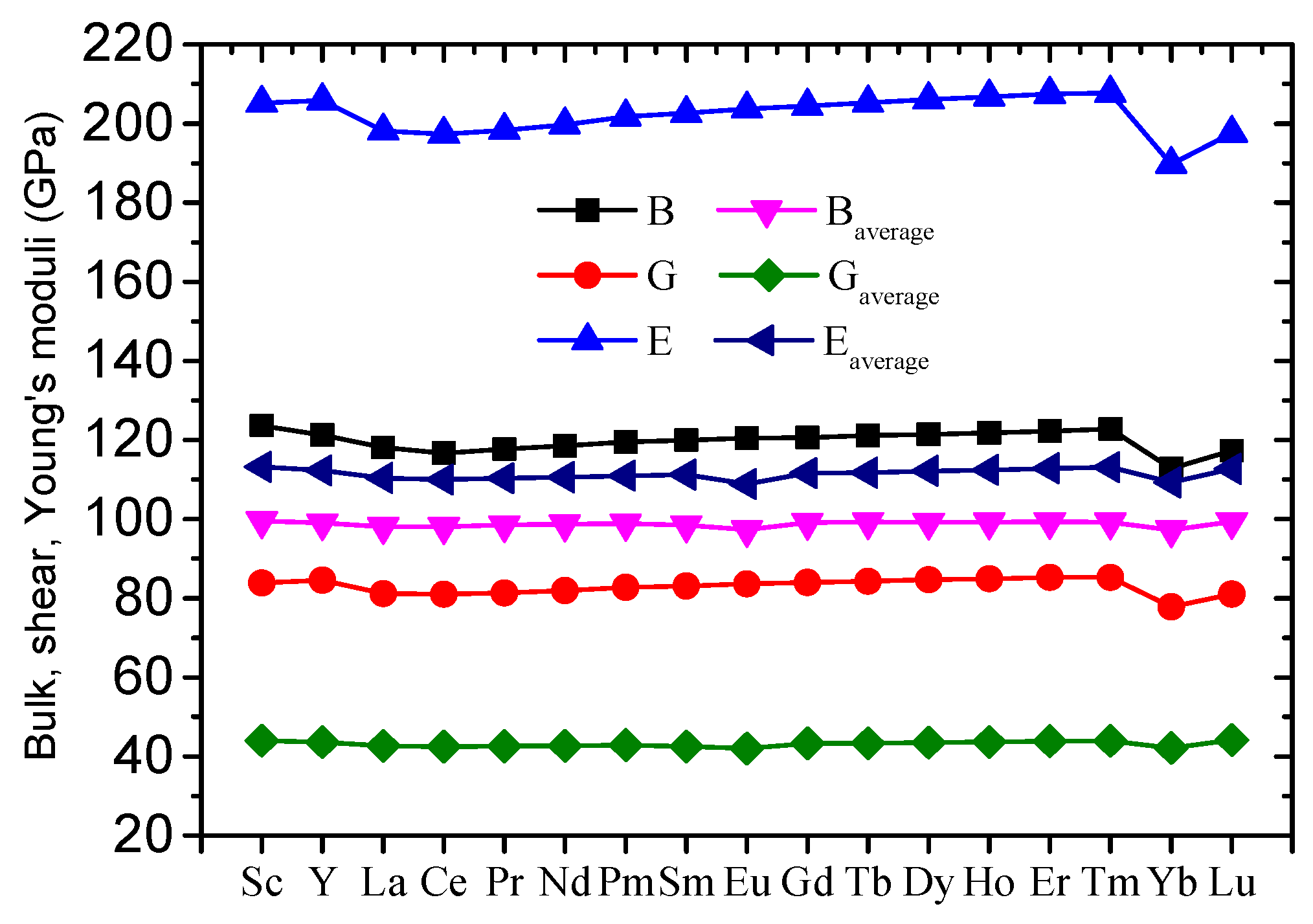

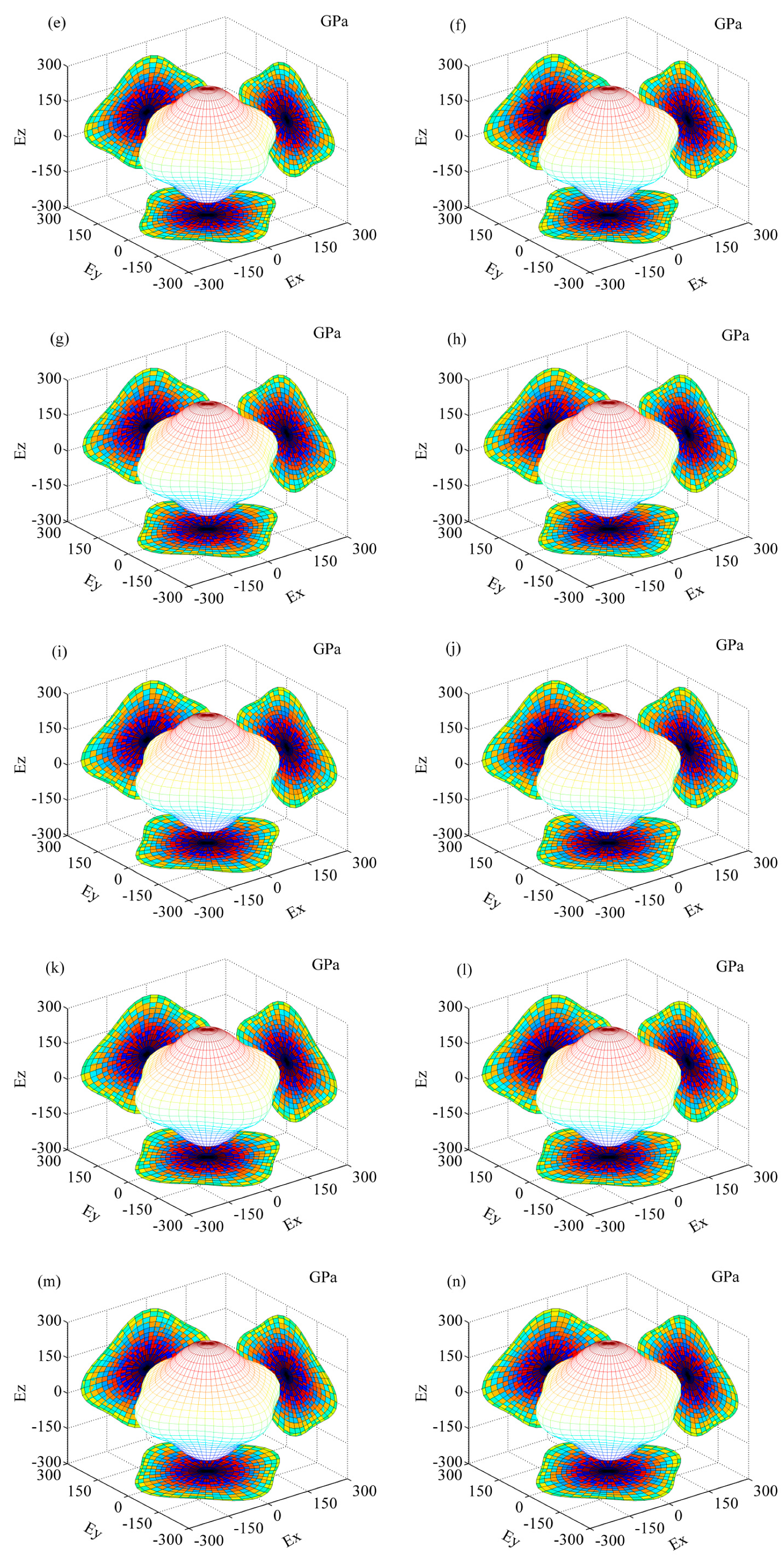
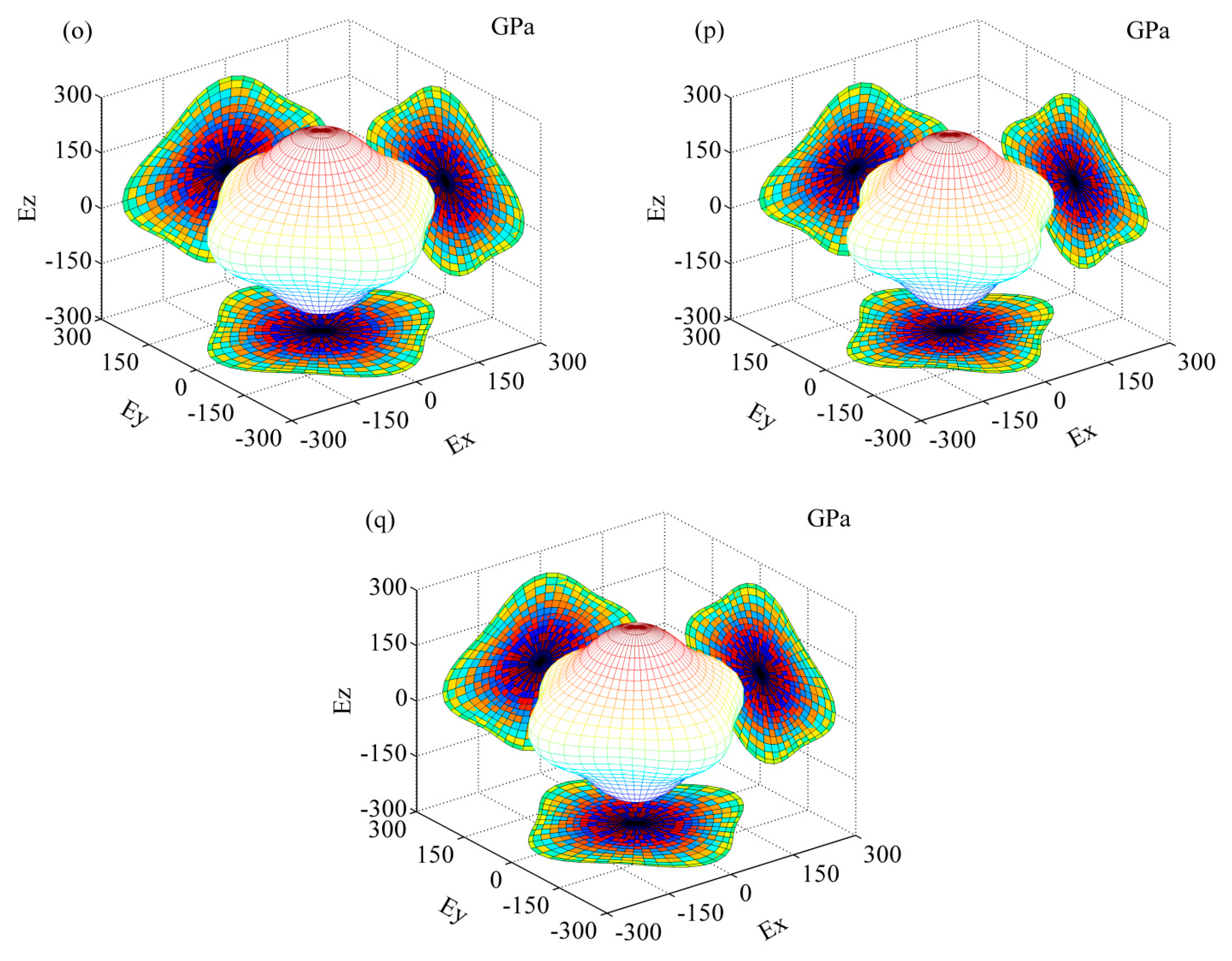
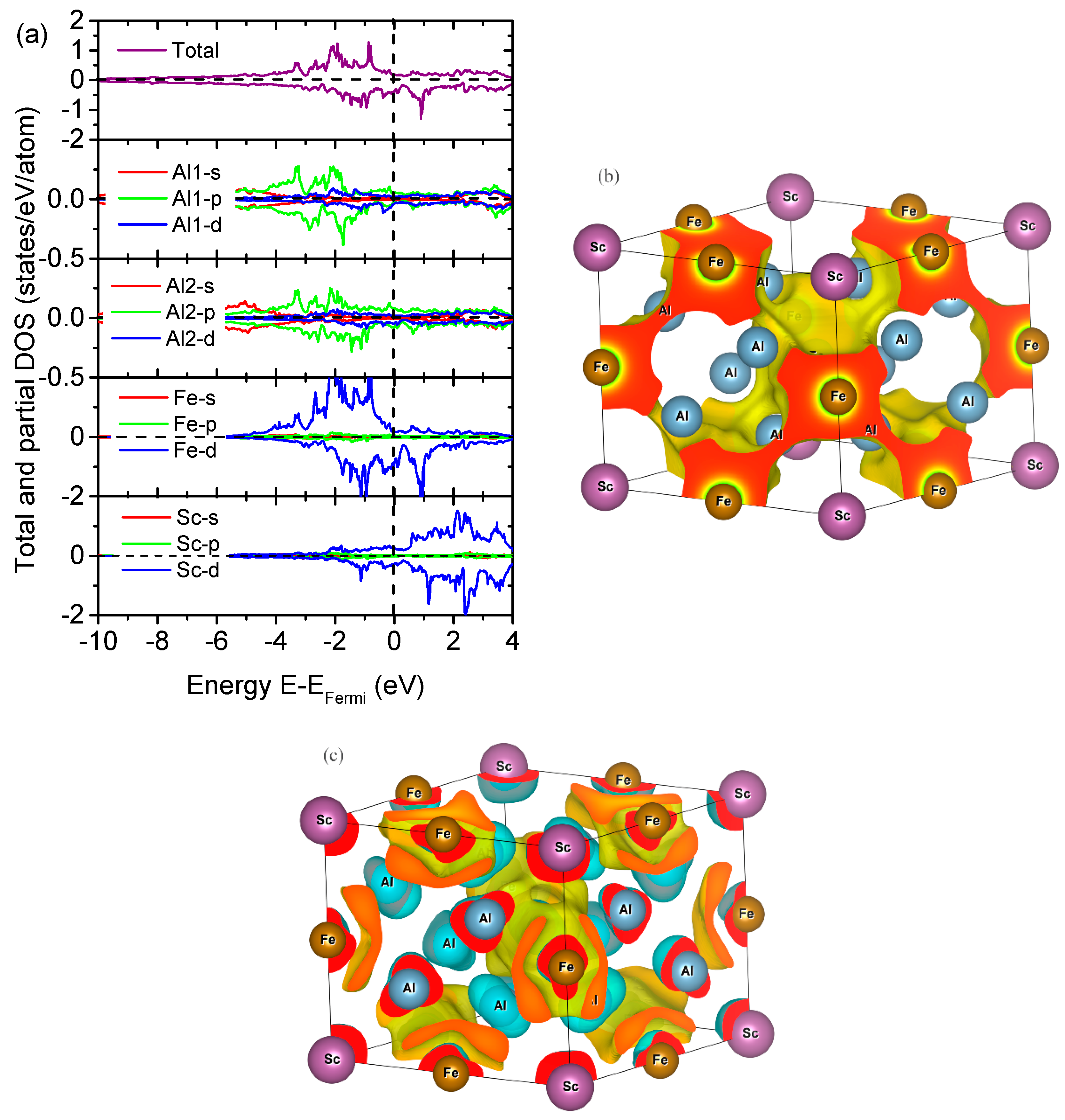
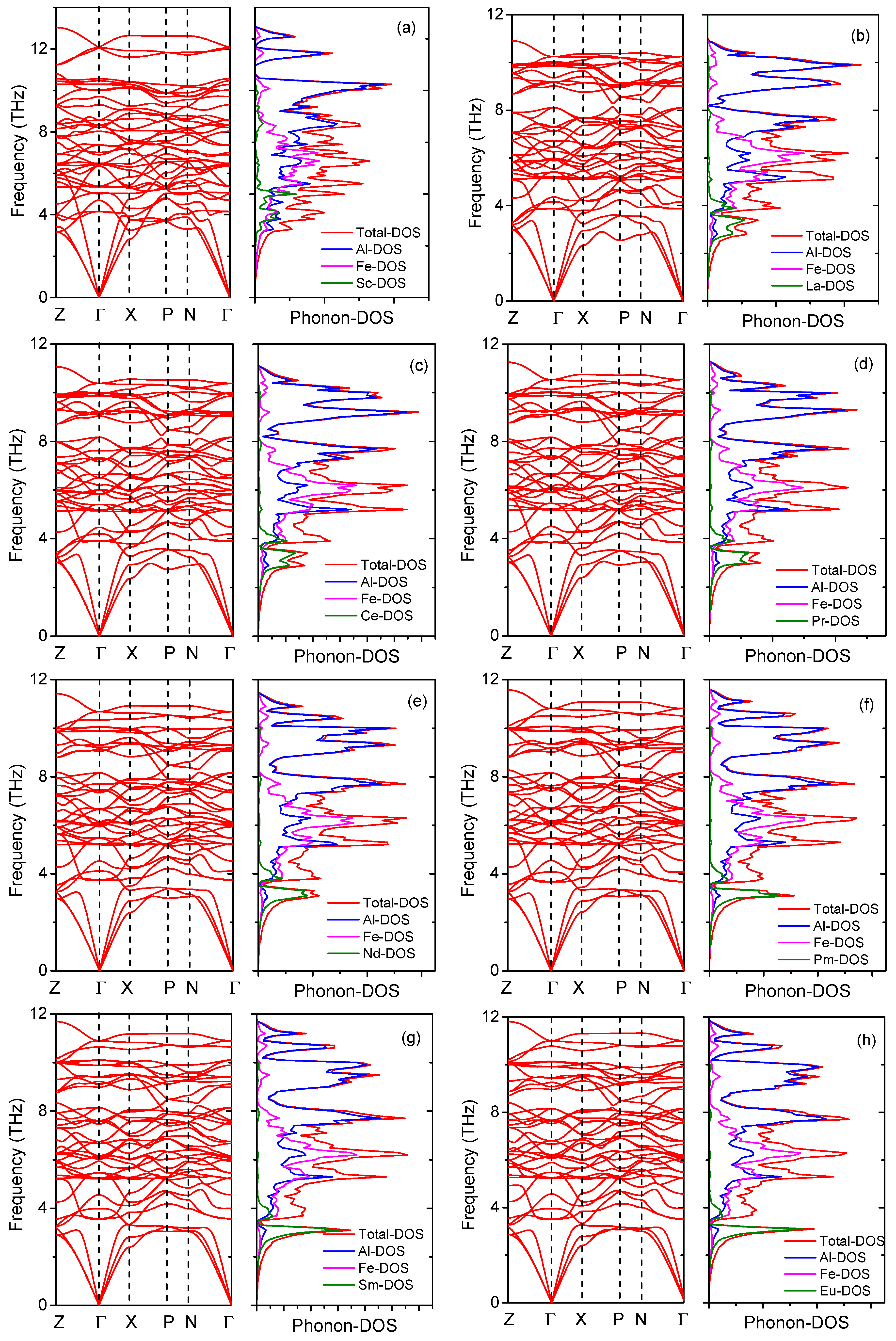
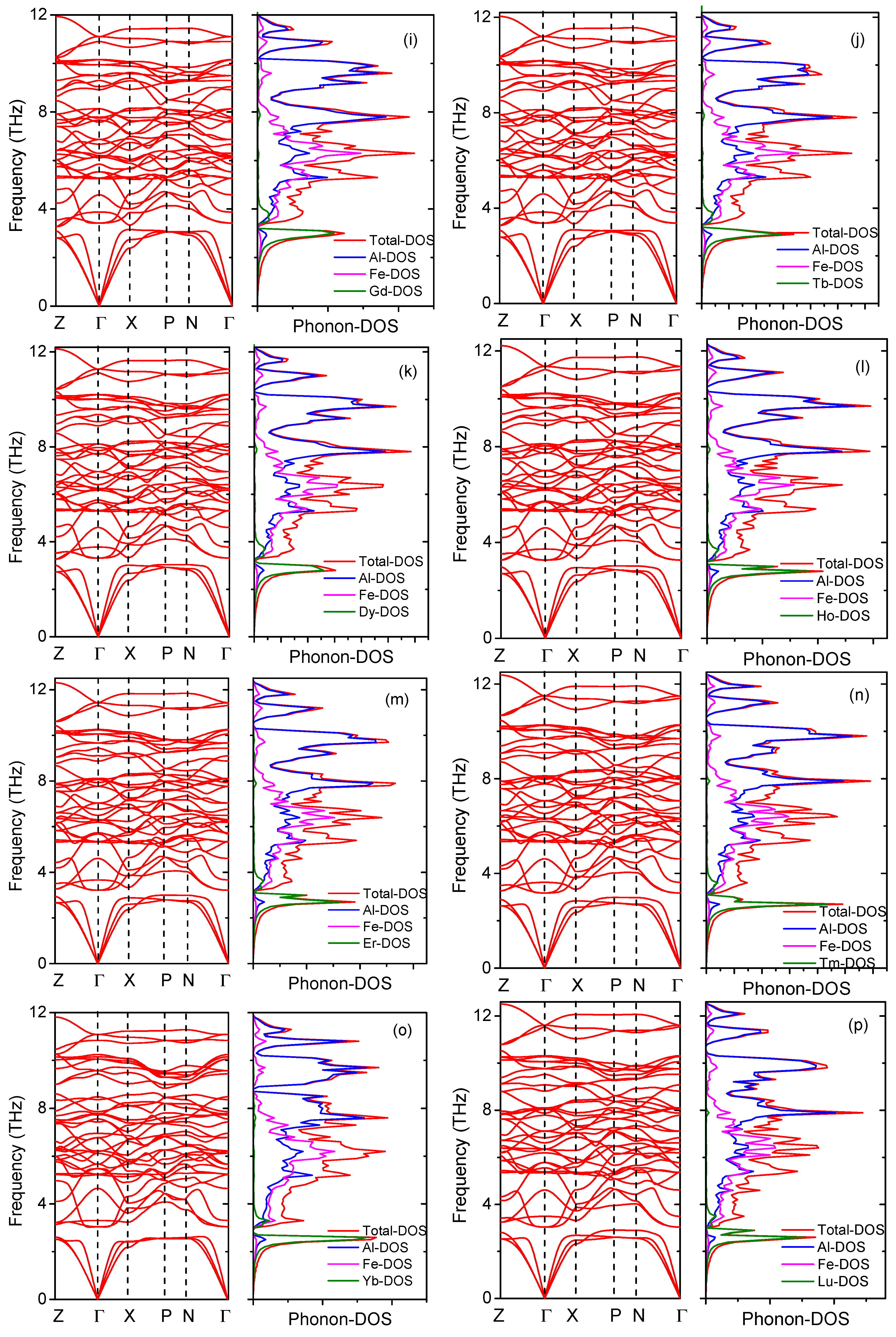
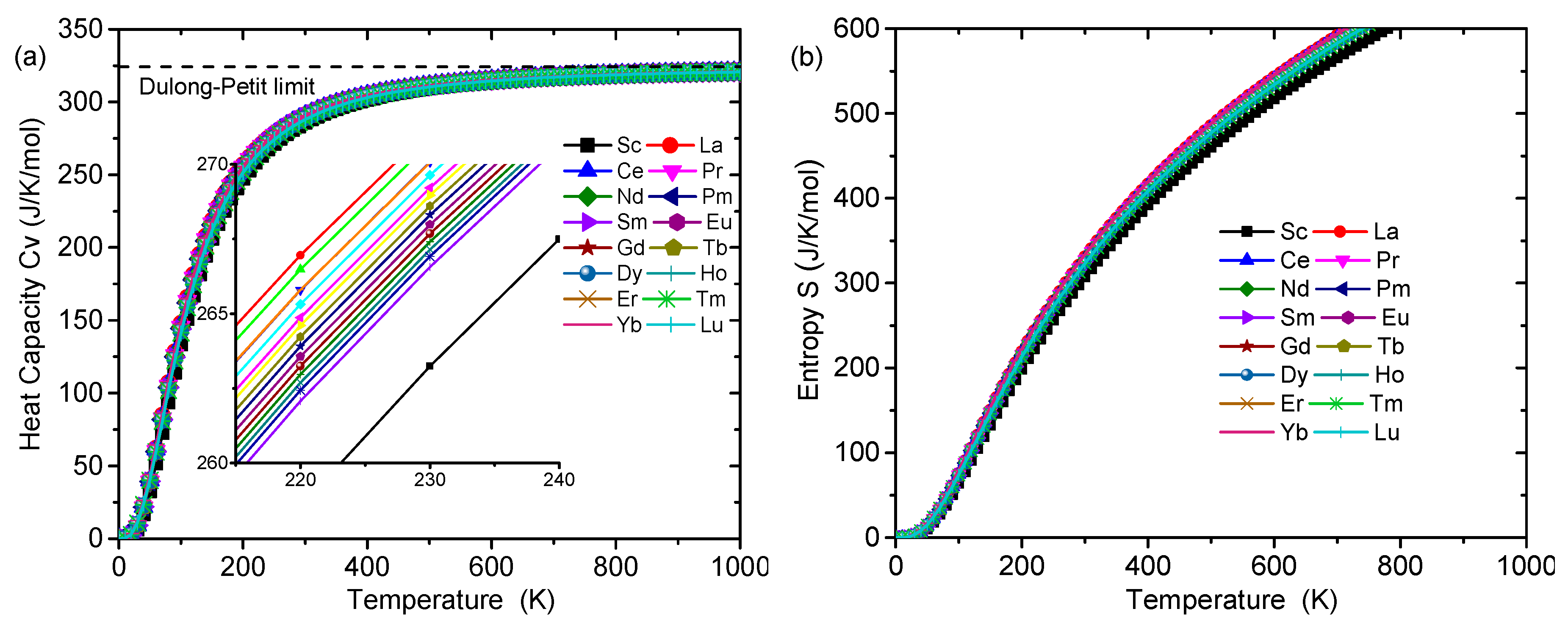
| Phases | Lattice Constants | △H (eV/atom) | Ec (eV/atom) | Magnetic (μB/Fe) | Ref. | |
|---|---|---|---|---|---|---|
| a (Å) | c (Å) | |||||
| Al8Fe4Sc | 8.597 8.70 | 5.001 4.81 | −0.4238 | −4.5211 | 1.426 | Present [14] |
| Al8Fe4Y | 8.696 8.750 | 5.024 5.060 | −0.4322 | −4.5221 | 1.500 | Present [14] |
| Al8Fe4La | 8.849 8.900 | 5.045 5.075 | −0.3843 | −4.4922 | 1.602 | Present [14] |
| Al8Fe4Ce | 8.829 8.793 | 5.046 5.047 | −0.3843 | −4.4963 | 1.599 | Present [14] |
| Al8Fe4Pr | 8.802 8.824 | 5.042 5.054 | −0.3955 | −4.5076 | 1.584 | Present |
| Al8Fe4Nd | 8.781 8.804 8.875 | 5.039 5.054 5.211 | −0.4043 | −4.5152 | 1.571 | Present [14,24] |
| Al8Fe4Pm | 8.762 | 5.035 | −0.4122 | −4.5173 | 1.559 | Present |
| Al8Fe4Sm | 8.748 8.770 8.863 | 5.032 5.053 5.188 | −0.4162 | −4.5223 | 1.549 | Present [14,24] |
| Al8Fe4Eu | 8.732 8.784 | 5.035 5.051 | −0.4328 | −4.5259 | 1.536 | Present [14] |
| Al8Fe4Gd | 8.719 8.743 | 5.028 5.052 | −0.4254 −0.6114 | −4.5283 | 1.524 | Present [14,38] |
| Al8Fe4Tb | 8.708 8.740 | 5.024 5.036 | −0.4277 | −4.5283 | 1.511 | Present [14] |
| Al8Fe4Dy | 8.697 8.728 | 5.022 5.050 | −0.4291 | −4.5275 | 1.499 | Present [14] |
| Al8Fe4Ho | 8.688 8.720 | 5.021 5.038 | −0.4298 | −4.5262 | 1.488 | Present [14] |
| Al8Fe4Er | 8.678 8.700 | 5.018 5.028 | −0.4296 | −4.5247 | 1.477 | Present [14] |
| Al8Fe4Tm | 8.669 8.688 | 5.016 5.037 | −0.4288 | −4.5224 | 1.466 | Present [14] |
| Al8Fe4Yb | 8.703 8.691 | 5.049 5.017 | −0.3652 | −4.2378 | 1.559 | Present [14] |
| Al8Fe4Lu | 8.653 8.687 | 5.012 5.030 | −0.4256 | −4.5174 | 1.450 | Present [14] |
| Phases | C11 | C12 | C13 | C33 | C44 | C66 |
|---|---|---|---|---|---|---|
| Al8Fe4Sc | 266.15 | 49.09 | 53.62 | 268.07 | 68.43 | 76.57 |
| Al8Fe4Y | 264.94 | 46.05 | 52.36 | 259.71 | 70.02 | 77.63 |
| Al8Fe4La | 254.17 | 41.90 | 52.25 | 262.29 | 67.73 | 70.86 |
| Al8Fe4Ce | 252.33 | 42.85 | 51.22 | 255.08 | 68.08 | 71.60 |
| Al8Fe4Pr | 255.29 | 43.90 | 51.40 | 255.34 | 68.35 | 71.43 |
| Al8Fe4Nd | 257.70 | 44.72 | 51.42 | 256.22 | 68.77 | 71.96 |
| Al8Fe4Pm | 260.29 | 45.46 | 51.61 | 257.71 | 69.33 | 73.14 |
| Al8Fe4Sm | 261.44 | 45.87 | 51.76 | 258.24 | 69.50 | 73.91 |
| Al8Fe4Eu | 262.97 | 46.12 | 51.84 | 258.83 | 69.74 | 74.79 |
| Al8Fe4Gd | 263.60 | 46.01 | 51.87 | 258.92 | 69.75 | 76.04 |
| Al8Fe4Tb | 264.58 | 46.22 | 52.25 | 259.89 | 69.80 | 76.95 |
| Al8Fe4Dy | 265.29 | 46.15 | 52.38 | 260.28 | 70.09 | 77.59 |
| Al8Fe4Ho | 265.91 | 46.22 | 52.78 | 261.12 | 70.39 | 78.01 |
| Al8Fe4Er | 266.61 | 46.29 | 53.14 | 261.95 | 70.74 | 78.24 |
| Al8Fe4Tm | 267.35 | 46.46 | 53.64 | 262.82 | 70.90 | 77.65 |
| Al8Fe4Yb | 247.62 | 38.03 | 48.66 | 249.15 | 64.34 | 66.59 |
| Al8Fe4Lu | 254.53 | 44.55 | 51.63 | 250.65 | 67.35 | 73.88 |
| Phases | B (GPa) | G (GPa) | E (GPa) | v | B/G | H |
|---|---|---|---|---|---|---|
| Al8Fe4Sc | 123.66 | 83.85 | 205.17 | 0.224 | 1.475 | 13.94 |
| Al8Fe4Y | 121.23 | 84.56 | 205.82 | 0.217 | 1.434 | 14.59 |
| Al8Fe4La | 118.10 | 81.19 | 198.17 | 0.220 | 1.454 | 13.90 |
| Al8Fe4Ce | 116.68 | 81.01 | 197.36 | 0.218 | 1.440 | 14.07 |
| Al8Fe4Pr | 117.69 | 81.36 | 198.36 | 0.219 | 1.447 | 14.02 |
| Al8Fe4Nd | 118.52 | 81.93 | 199.76 | 0.219 | 1.447 | 14.09 |
| Al8Fe4Pm | 119.51 | 82.76 | 201.72 | 0.218 | 1.444 | 14.23 |
| Al8Fe4Sm | 119.99 | 83.12 | 202.59 | 0.219 | 1.444 | 14.28 |
| Al8Fe4Eu | 120.49 | 83.61 | 203.70 | 0.218 | 1.441 | 14.37 |
| Al8Fe4Gd | 120.63 | 83.96 | 204.44 | 0.218 | 1.437 | 14.48 |
| Al8Fe4Tb | 121.16 | 84.28 | 205.26 | 0.218 | 1.438 | 14.50 |
| Al8Fe4Dy | 121.41 | 84.65 | 206.05 | 0.217 | 1.434 | 14.69 |
| Al8Fe4Ho | 121.83 | 84.94 | 206.78 | 0.217 | 1.434 | 14.63 |
| Al8Fe4Er | 122.25 | 85.24 | 207.50 | 0.217 | 1.434 | 14.67 |
| Al8Fe4Tm | 122.78 | 85.25 | 207.68 | 0.218 | 1.440 | 14.58 |
| Al8Fe4Yb | 112.76 | 77.80 | 189.76 | 0.220 | 1.449 | 13.55 |
| Al8Fe4Lu | 117.26 | 81.02 | 197.57 | 0.219 | 1.447 | 13.97 |
© 2019 by the authors. Licensee MDPI, Basel, Switzerland. This article is an open access article distributed under the terms and conditions of the Creative Commons Attribution (CC BY) license (http://creativecommons.org/licenses/by/4.0/).
Share and Cite
Wang, R.; Tao, X.; Chen, H.; Ouyang, Y. Phase Stability and Mechanical Properties of Al8Fe4RE via First-Principle Calculations. Materials 2019, 12, 701. https://doi.org/10.3390/ma12050701
Wang R, Tao X, Chen H, Ouyang Y. Phase Stability and Mechanical Properties of Al8Fe4RE via First-Principle Calculations. Materials. 2019; 12(5):701. https://doi.org/10.3390/ma12050701
Chicago/Turabian StyleWang, Rongcheng, Xiaoma Tao, Hongmei Chen, and Yifang Ouyang. 2019. "Phase Stability and Mechanical Properties of Al8Fe4RE via First-Principle Calculations" Materials 12, no. 5: 701. https://doi.org/10.3390/ma12050701
APA StyleWang, R., Tao, X., Chen, H., & Ouyang, Y. (2019). Phase Stability and Mechanical Properties of Al8Fe4RE via First-Principle Calculations. Materials, 12(5), 701. https://doi.org/10.3390/ma12050701





